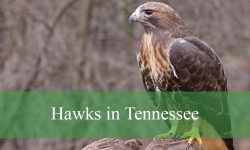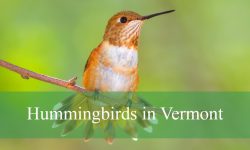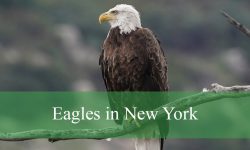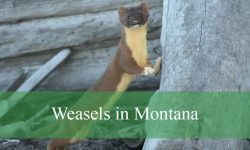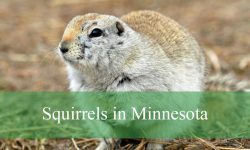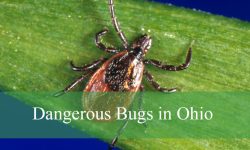In Colorado, a stunning variety of blue birds brighten the skies and landscapes, from vibrant songbirds to striking jays and swallows. Each species brings unique colors, songs, and behaviors that make birdwatching an exciting experience.
Across open grasslands, foothills, rivers, wetlands, and suburban gardens, blue birds inhabit diverse habitats. Some species stay year-round, while others migrate through the state, adding seasonal interest for bird enthusiasts.
This guide showcases 15 blue birds in Colorado, offering detailed identification tips, size, behavior, and the best places and times to observe them. The information helps both casual observers and avid birders spot and appreciate these beautiful birds.
Types of Blue Birds Found in Colorado
Mountain Bluebird
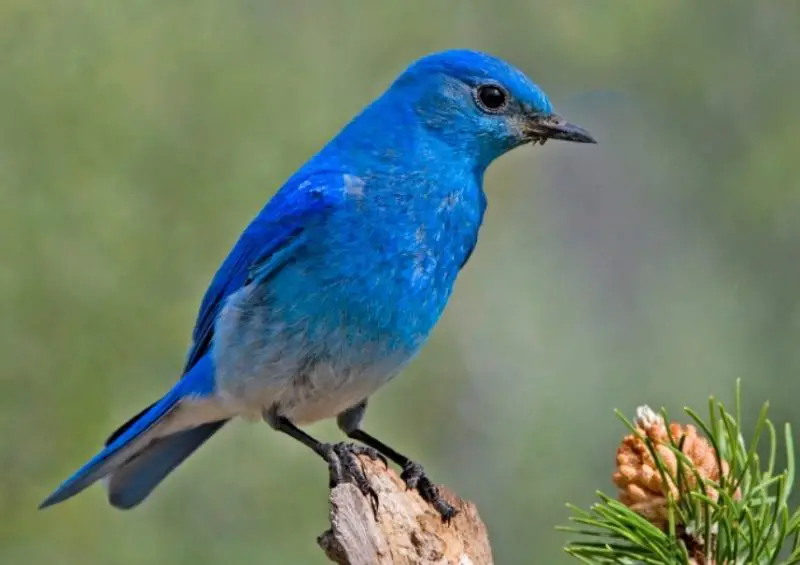
The Mountain Bluebird (Sialia currucoides) is a small thrush with a striking sky-blue color that makes it one of Colorado’s most iconic blue birds. Males are bright blue all over, while females are more muted with grayish-blue tones. This species measures about 6.3–7.1 inches (16–18 cm) in length with a wingspan of 11–13 inches (28–33 cm).
Mountain Bluebirds are cavity nesters, often using abandoned woodpecker holes or nest boxes. They primarily feed on insects during summer and switch to berries and seeds in winter. Their flight is direct and graceful, often gliding low over open fields or meadows.
You can identify them by their vivid blue color, lighter underparts, and slender shape. Females appear grayish-blue but are distinguishable by their lighter throat and breast. In flight, the blue upperparts shine in the sunlight, making them easier to spot.
In Colorado, Mountain Bluebirds are most commonly seen in open grasslands, prairies, and alpine meadows, especially in the western and central parts of the state. Spring and summer, particularly April through August, are the best times to observe them, often perched on fence posts or hovering over fields hunting insects.
Western Bluebird
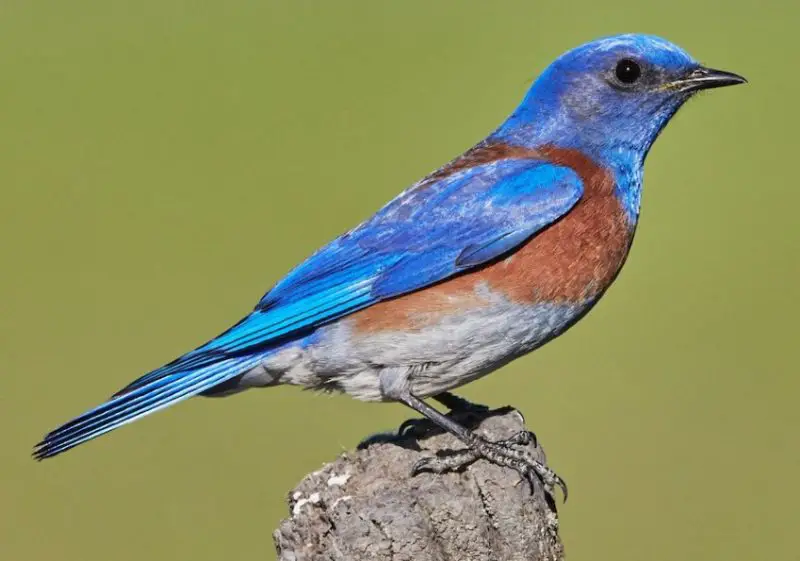
The Western Bluebird (Sialia mexicana) is slightly smaller than the Mountain Bluebird, measuring about 6–7 inches (15–18 cm) in length with a wingspan of 11–12 inches (28–31 cm). Males have bright blue wings and head with a rusty orange chest, while females are duller with bluish-gray tones.
This species prefers open woodlands, forest edges, and areas with scattered trees and shrubs. They are cavity nesters, frequently using nest boxes, and often compete with House Sparrows or Tree Swallows for suitable sites. Their diet includes insects, spiders, and berries.
Western Bluebirds are social birds outside the breeding season, sometimes forming small flocks. They exhibit a characteristic bobbing behavior when perched and have a soft, musical warble. Identification is easier thanks to the combination of blue and orange plumage on males, while females are more muted but show subtle blue wings and tail.
In Colorado, Western Bluebirds are commonly observed in foothills, open woodlands, and meadows, especially during spring and summer. Best viewing spots include parks with scattered trees and rural roads with open fields.
Eastern Bluebird
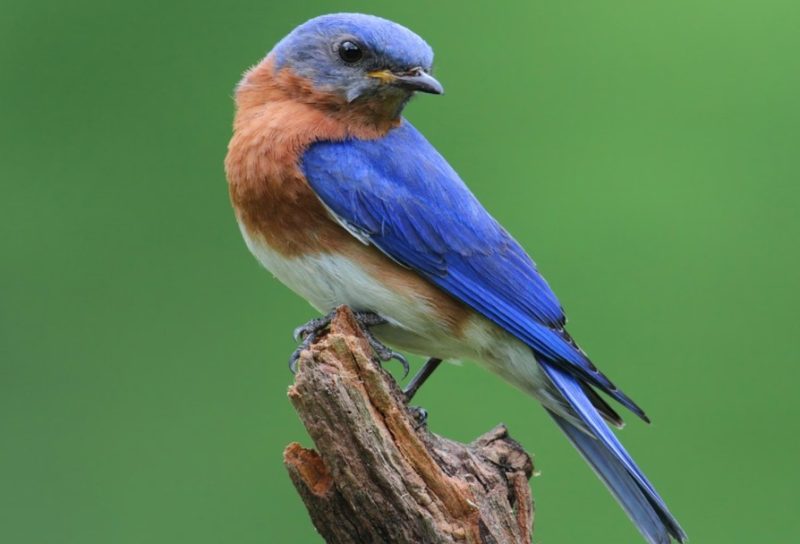
The Eastern Bluebird (Sialia sialis) is a slightly smaller thrush, about 6–7 inches (15–18 cm) in length with an 11–13 inch (28–33 cm) wingspan. Males feature bright blue backs and heads with rusty red throats and chest, while females are duller, with grayish-blue wings and lighter underparts.
Eastern Bluebirds inhabit open areas with scattered trees, farmlands, orchards, and suburban parks. They are cavity nesters, often using nest boxes, and feed mainly on insects during summer and berries in winter. They are known for their graceful hovering flight while hunting for insects on the ground.
Identification is straightforward: males display vivid blue on their back and wings with a reddish chest, while females have more subtle colors but maintain bluish wings and tail. Their soft, melodious warbling song makes them easy to hear even before seeing them.
In Colorado, they are most commonly spotted in the eastern plains and open habitats from spring through early fall. Nest boxes in open fields or along fence lines increase your chance of observing these charming birds up close.
Blue Jay
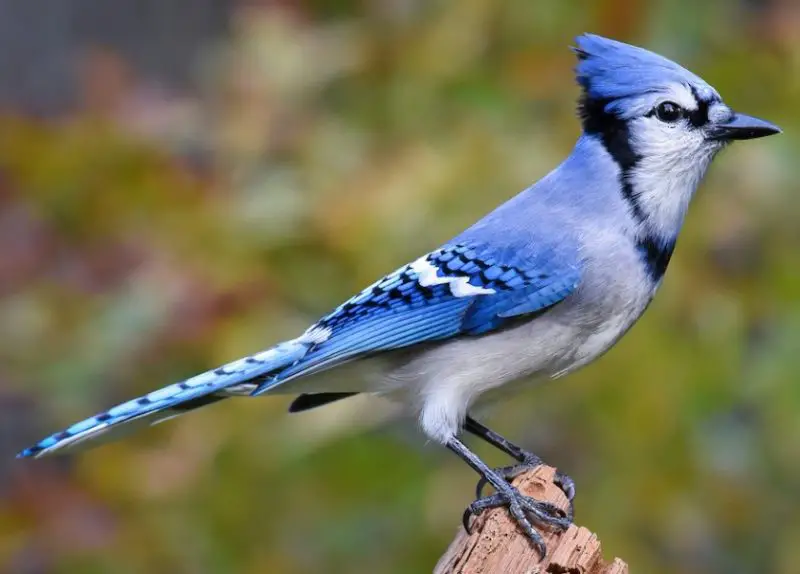
The Blue Jay (Cyanocitta cristata) is a larger, striking bird measuring 9–12 inches (23–30 cm) in length with a wingspan of 13–17 inches (34–43 cm). Its bright blue upperparts, white chest, and black markings across the neck and face make it unmistakable.
Blue Jays are highly intelligent and social, often seen in family groups or mixed-species flocks. They feed on nuts, seeds, insects, and occasionally small vertebrates. They are known for their loud, varied calls and their habit of mimicking hawks to scare away predators.
Identification is easy thanks to their vivid blue color, prominent crest, and black necklace pattern. In flight, their blue and white wing patterns stand out, while their bold personality makes them noticeable in both urban and forested areas.
In Colorado, Blue Jays are most common in the eastern and central regions with deciduous or mixed forests. Spring and fall migrations are ideal times to observe them, particularly near oak trees where they forage for acorns.
Lazuli Bunting
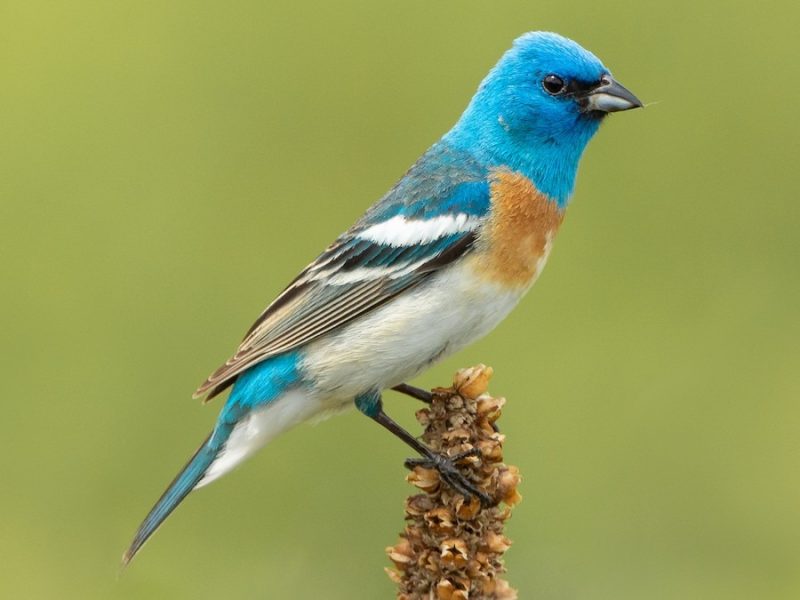
The Lazuli Bunting (Passerina amoena) is a small songbird about 4.5–5 inches (11–13 cm) long with a wingspan of 7.5–9 inches (19–23 cm). Males are striking with bright blue heads, backs, and wings, a white belly, and a warm orange chest. Females are duller with gray-brown tones and faint blue on wings and tail.
They inhabit brushy areas, open woodlands, and riparian zones, often staying near low shrubs. Their diet consists mainly of insects during the breeding season and seeds or berries at other times. Lazuli Buntings are known for their short, sweet, high-pitched songs, often delivered from perches in the open.
Identification is easiest with males’ vivid blue and orange contrast, while females are subtler but show faint blue hints on their wings. Their quick, hopping movements among shrubs can help spot them even when partially hidden.
In Colorado, they are best observed in the western and central regions during late spring and summer, particularly along streams, edges of meadows, and brushy slopes. Early mornings and late afternoons are prime times to catch their colorful displays and singing behavior.
Indigo Bunting
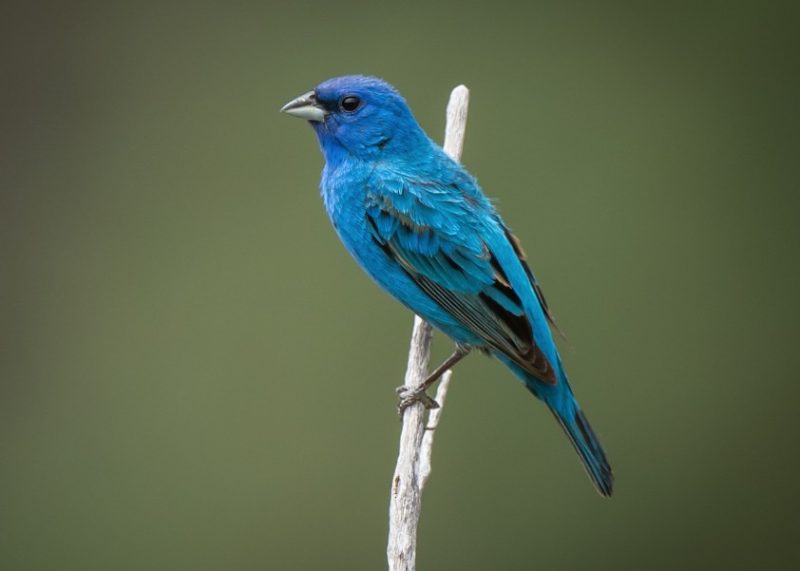
The Indigo Bunting (Passerina cyanea) is a small songbird, measuring 4.5–5 inches (11–13 cm) in length with a wingspan of 7.5–9 inches (19–23 cm). Males are vibrant blue all over during the breeding season, while females are brown with faint blue tinges on the wings and tail.
Indigo Buntings favor brushy edges, woodland clearings, and fields with scattered shrubs. They primarily feed on insects, berries, and seeds. During the breeding season, males sing from prominent perches to establish territories, often performing a fluttering display flight.
Identification is straightforward: males’ bright, uniform blue plumage is unmistakable, while females are subtler but can be recognized by their pale underparts and slightly blue wings. Their high-pitched, musical song helps locate them even when hidden in dense brush.
In Colorado, Indigo Buntings are most commonly observed during late spring and summer, particularly in the eastern plains and foothills. Early morning is ideal for spotting them as males sing and forage actively among shrubs.
Tree Swallow
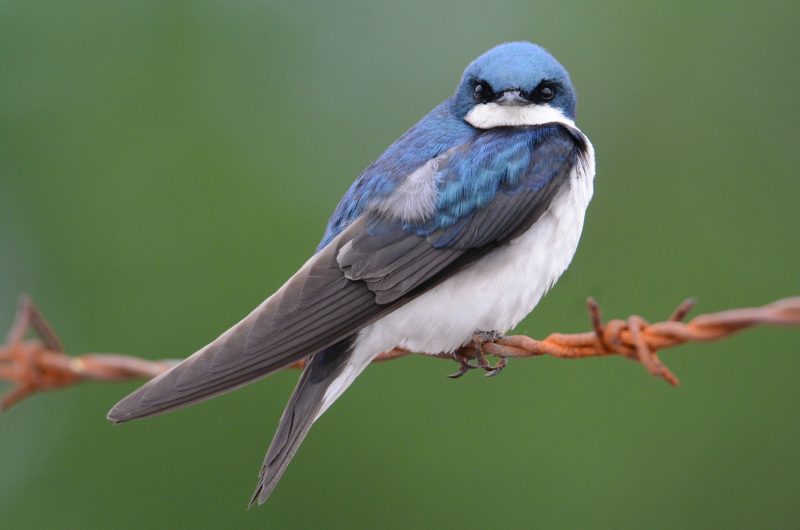
The Tree Swallow (Tachycineta bicolor) is a small migratory bird measuring 5–6 inches (13–15 cm) in length with a wingspan of 11–12 inches (28–30 cm). Adult males have iridescent blue-green upperparts and bright white underparts, while females appear slightly duller with more grayish tones.
These birds nest in cavities or nest boxes near wetlands, ponds, and open fields. They feed almost exclusively on flying insects, catching them mid-air with agile flight maneuvers. Tree Swallows often gather in large flocks outside the breeding season, creating spectacular aerial displays.
Identification is aided by their glossy blue-green backs and white underparts, combined with their swift, acrobatic flight. Females’ duller coloration may make them harder to spot, but their graceful movements and group behavior are distinctive.
In Colorado, they are most common from spring through summer, particularly near lakes, ponds, and marshes in the central and eastern regions. Early morning or late afternoon are prime times to watch them swooping over water in pursuit of insects.
Violet-green Swallow
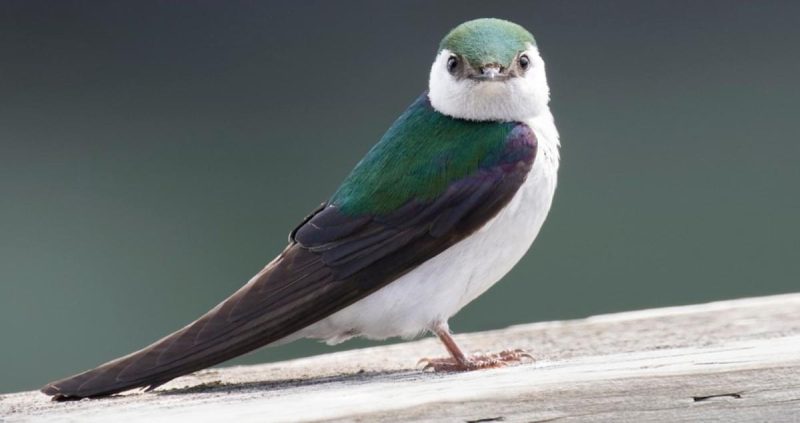
The Violet-green Swallow (Tachycineta thalassina) is similar in size to the Tree Swallow, measuring 5–6 inches (13–15 cm) in length with a wingspan of 11–12 inches (28–30 cm). Males and females share iridescent green upperparts with violet patches on the shoulders and white underparts.
They prefer open habitats with cliffs, forest edges, and near water bodies for nesting. These swallows are aerial insectivores, often forming flocks that perform synchronized feeding flights. They readily use nest boxes and old woodpecker cavities for breeding.
Identification is distinguished by the unique violet shoulder patches contrasting with green back feathers. Their white rump is also a key feature when seen in flight. Their rapid, gliding flight and aerial acrobatics make them easily recognizable to birdwatchers.
In Colorado, Violet-green Swallows are most often seen in spring and summer across western and central mountainous regions. Lakeshores, meadows, and cliffside nest boxes provide excellent viewing opportunities.
Blue-gray Gnatcatcher
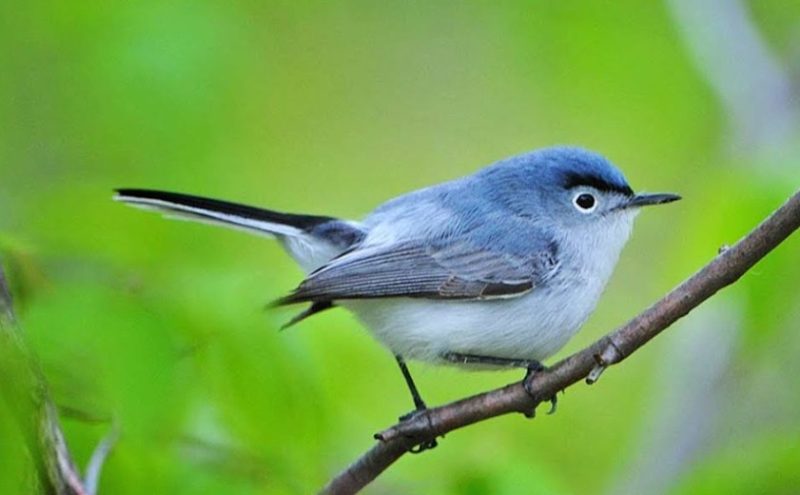
The Blue-gray Gnatcatcher (Polioptila caerulea) is a small songbird, about 4–5 inches (10–13 cm) long with a wingspan of 6–8 inches (15–20 cm). It has pale bluish-gray upperparts, white underparts, and a long tail edged with white.
They inhabit open woodlands, riparian areas, and shrublands, often flitting actively among branches while foraging for insects and spiders. Their constant tail-flicking behavior and soft, high-pitched calls make them noticeable despite their small size.
Identification is aided by the overall bluish-gray color, white eye-ring, and slender build. Males are slightly darker on the back than females.
In Colorado, they are most commonly seen in spring and summer across riparian corridors and open forested areas. Early morning observation is ideal to catch their active foraging and singing.
Barn Swallow

The Barn Swallow (Hirundo rustica) is slightly larger, measuring 5.5–7 inches (14–18 cm) in length with a wingspan of 11–13 inches (28–33 cm). Adult males have glossy blue backs, reddish throats, and long forked tails, while females are slightly duller with shorter tails.
They are highly adaptable, nesting in barns, under bridges, and on other man-made structures. Barn Swallows feed almost entirely on flying insects, catching them in flight with remarkable agility. Their aerial displays and long migrations make them a favorite for birdwatchers.
Identification is aided by the glossy blue back, rufous throat, and deeply forked tail in males. In flight, their long tails and swift maneuvers are unmistakable. Females and juveniles have similar patterns but are paler and less striking.
In Colorado, Barn Swallows are widespread during spring and summer, particularly near farms, open fields, and water sources. They are active during the day, often seen swooping low over ponds or fields while foraging.
Belted Kingfisher
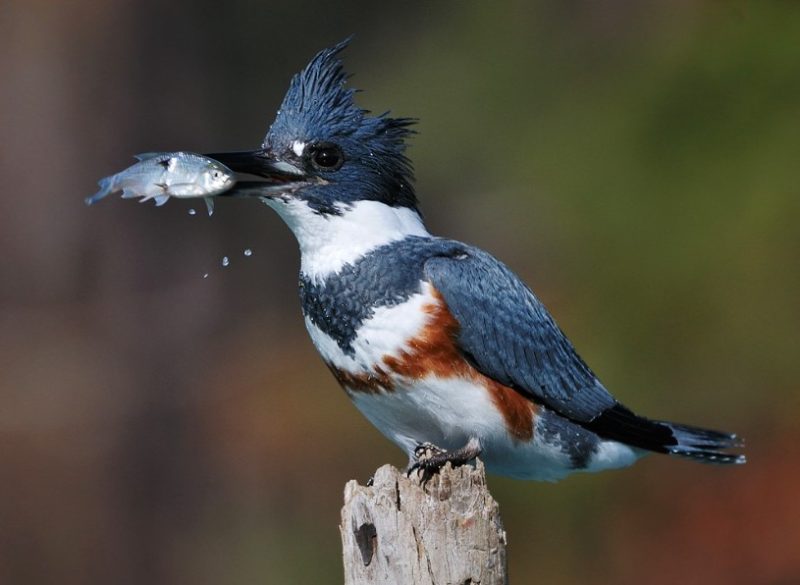
The Belted Kingfisher (Megaceryle alcyon) is a medium-sized bird, measuring 11–14 inches (28–36 cm) in length with a wingspan of 19–23 inches (48–59 cm). Males have slate-blue upperparts and white underparts with a single blue breast band, while females show an additional rusty band across the belly.
They are typically found near rivers, lakes, and ponds, where they hunt by diving into water to catch fish. Belted Kingfishers perch on exposed branches or posts near water, scanning for prey with sharp eyesight. They also eat crustaceans, amphibians, and aquatic insects.
Identification is aided by their large head, shaggy crest, blue-gray color, and distinctive rattling call. Their plunging dives into water and hovering before dives make them fascinating to observe. Females’ extra rusty band helps distinguish sexes in the field.
In Colorado, Belted Kingfishers are most commonly seen near lakes, reservoirs, and rivers during spring through fall. Early morning or late afternoon is ideal for spotting their hunting dives along calm waters.
Steller’s Jay
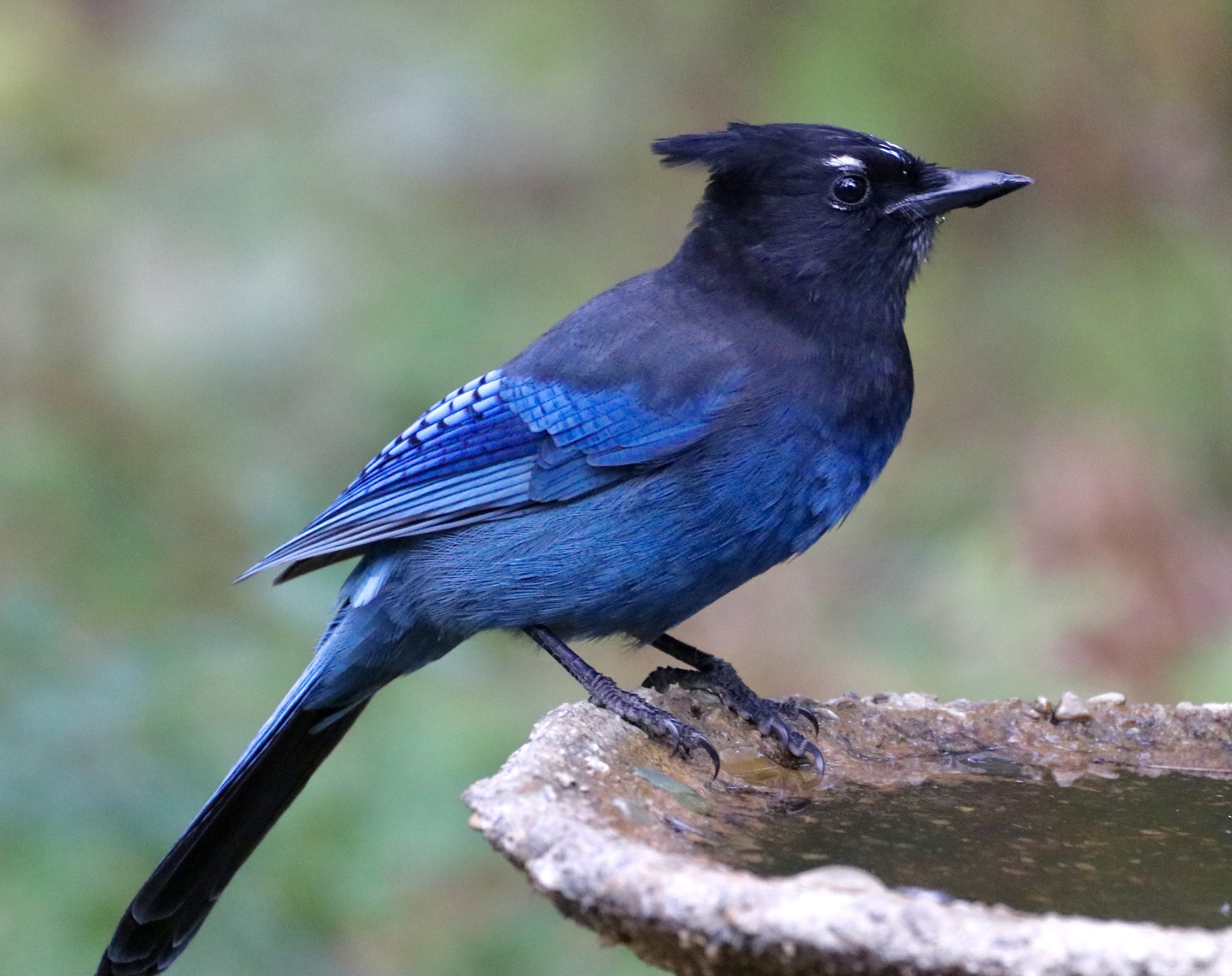
The Steller’s Jay (Cyanocitta stelleri) is a striking, medium-sized bird about 11–13 inches (28–33 cm) long with a wingspan of 13–17 inches (33–43 cm). It has deep blue upperparts, black head, and prominent crest, with lighter blue streaks on the wings and tail.
Steller’s Jays are bold and intelligent, often seen in coniferous forests, mountain foothills, and suburban areas. They feed on seeds, nuts, berries, insects, and occasionally eggs or nestlings. They are known for loud calls, mimicry, and caching food for later consumption.
Identification is straightforward due to the dark crested head, vivid blue body, and noisy, inquisitive behavior. They often forage on the ground or in trees, sometimes approaching humans in campgrounds or parks.
In Colorado, Steller’s Jays are most abundant in mountainous areas and forested regions during spring and summer, though they remain year-round in many locations. Early morning and late afternoon are best for observing their active foraging and vocal displays.
Purple Martin
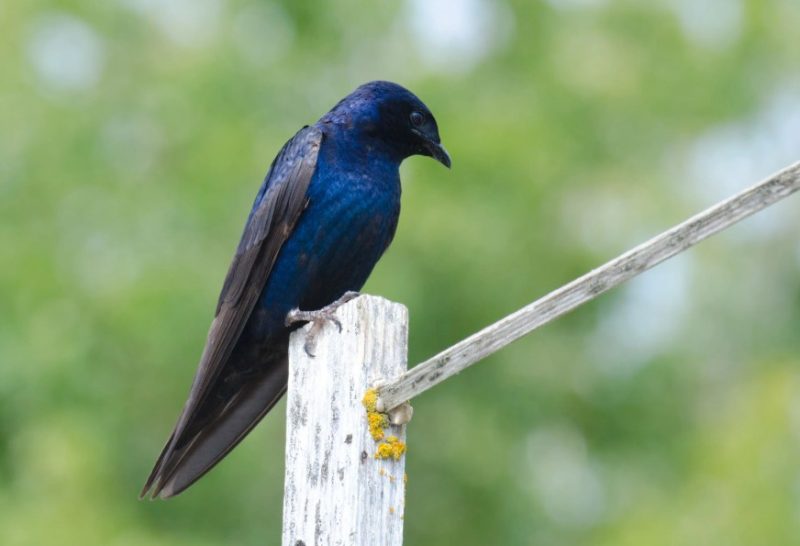
The Purple Martin (Progne subis) is the largest North American swallow, measuring 7–8 inches (18–21 cm) in length with a wingspan of 12–16 inches (30–41 cm). Adult males are glossy dark blue-purple all over, while females are paler with grayish underparts.
They are highly social and prefer human-provided nesting boxes in open areas, often forming large colonies. Purple Martins feed almost exclusively on flying insects, catching them in swift, graceful aerial maneuvers. Their presence is often accompanied by the chatter of multiple birds in communal roosts.
Identification is aided by the adult male’s glossy purple sheen and the slightly lighter female plumage. In flight, their long wings and forked tails, along with gliding and swooping behavior, make them easy to distinguish.
In Colorado, Purple Martins are most commonly observed during late spring and summer, especially in open meadows, suburban areas, and near water where nesting colonies are established. Early mornings are ideal for watching their active feeding flights.
Western Scrub-Jay
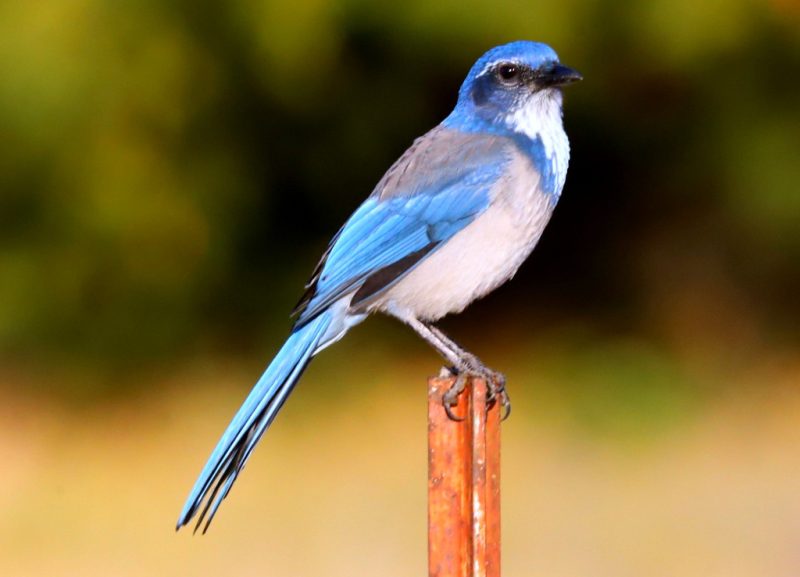
The Western Scrub-Jay (Aphelocoma californica) is a medium-sized bird, about 11–12 inches (28–31 cm) in length with a wingspan of 15–17 inches (38–43 cm). It has bright blue wings and tail, a grayish back, and a pale underbelly with a blue necklace across the chest.
They are adaptable birds, commonly found in oak woodlands, scrublands, and suburban areas. Western Scrub-Jays are omnivorous, feeding on insects, fruits, seeds, and small vertebrates. They are known for their bold behavior, loud calls, and caching habits.
Identification is relatively easy due to the combination of blue wings, long tail, and grayish back, along with their inquisitive and often noisy behavior. They are frequently seen foraging on the ground or hopping along branches in search of food.
In Colorado, Western Scrub-Jays are most abundant in the western and southern foothills. Spring and summer are the best times to observe them, especially around oak trees where they search for acorns and insects.
Blue Grosbeak
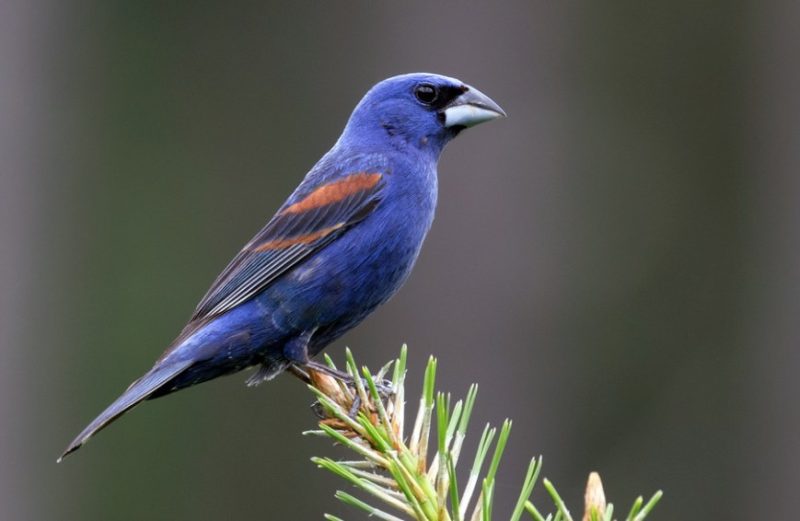
The Blue Grosbeak (Passerina caerulea) is a medium-sized songbird, about 6–7 inches (15–18 cm) in length with a wingspan of 9–11 inches (23–28 cm). Males are rich cobalt blue with chestnut wing bars, while females are brownish with subtle blue hints.
They inhabit open woodlands, brushy fields, and riparian areas, often perching conspicuously while singing a rich, warbling song. They feed on insects, seeds, and small fruits, and males often sing from prominent perches to defend territories.
Identification is straightforward for males due to their striking deep blue color and chestnut wing bars. Females are subtler but show faint blue tones on the wings and tail.
In Colorado, Blue Grosbeaks are most commonly observed in late spring and summer, particularly in the southeastern and southern parts of the state. Early mornings are ideal for observing their song and active foraging behavior.
Best Times and Places to Observe Blue Birds in Colorado
Blue birds in Colorado are generally most visible during the spring and summer months, from April through August, when they are actively breeding and feeding their young. Migratory species such as Indigo Bunting, Tree Swallow, and Purple Martin are typically present from late April to early September. Resident species like Mountain Bluebird, Western Bluebird, and Blue Jay can be seen throughout the year, especially in open meadows and forest edges.
The best times of day for birdwatching are early mornings and late afternoons, when birds are most active in foraging and singing. Midday is usually less productive because many species rest or seek shade during the hottest part of the day.
Open grasslands and prairies provide excellent viewing opportunities for Mountain and Western Bluebirds, particularly in central and western Colorado. Foothills and open woodlands attract Western Bluebirds, Steller’s Jays, and Western Scrub-Jays. Riparian areas, ponds, and wetlands are ideal habitats for Tree Swallows, Violet-green Swallows, Barn Swallows, and Belted Kingfishers.
Suburban parks and gardens often host Eastern Bluebirds, Blue Jays, and Purple Martins, especially when nest boxes or bird feeders are present. Desert scrub and arid woodlands are suitable for Ash-throated Flycatchers and Lazuli Buntings, mainly in the southern and western regions of the state.
Bringing binoculars, a field guide, and a notebook for observations enhances the birdwatching experience. Patience is essential, particularly for secretive or migratory species that may be less active or harder to spot.
FAQs About Blue Birds in Colorado
What is the easiest blue bird to spot in Colorado?
The Mountain Bluebird is one of the easiest to observe due to its bright blue plumage, preference for open habitats, and frequent perching on fence posts or telephone lines.
Are Blue Jays common throughout Colorado?
Blue Jays are fairly common in the eastern and central regions that contain deciduous or mixed forests. Their bold behavior and loud calls make them easier to detect than many other species.
Can I see all these blue birds in one location?
Not usually. Different species prefer distinct habitats, such as mountain meadows, deserts, or wetlands, and migratory species are present only during certain seasons. Visiting a variety of locations increases the chances of seeing multiple species.
Do I need a bird feeder to see these blue birds?
Feeders are not necessary, though they can attract Blue Jays, Eastern Bluebirds, and Western Scrub-Jays. Nest boxes are particularly helpful for Mountain, Western, and Eastern Bluebirds, encouraging them to stay in specific areas.
When is the best season to see migratory blue birds?
Spring, from April to June, is the optimal time for observing migratory males in their full breeding plumage. Some species, including Indigo Buntings and Purple Martins, remain through late summer, but most leave by early September.
Are these blue birds threatened or protected?
Most of these species are not currently threatened and are protected under the Migratory Bird Treaty Act. It is illegal to harm them or disturb their nests, so observing from a safe distance is recommended.

